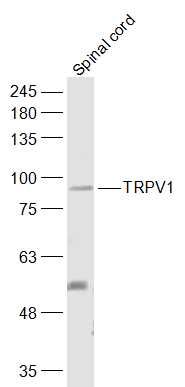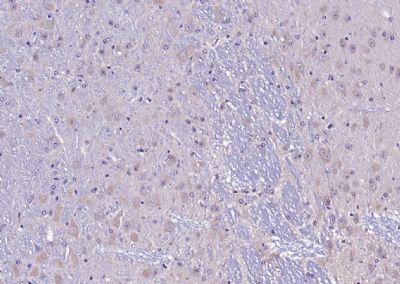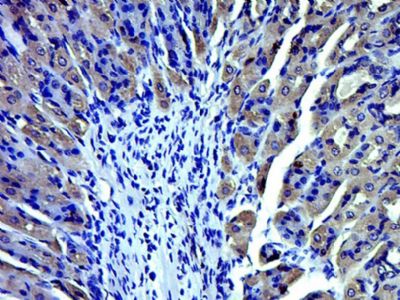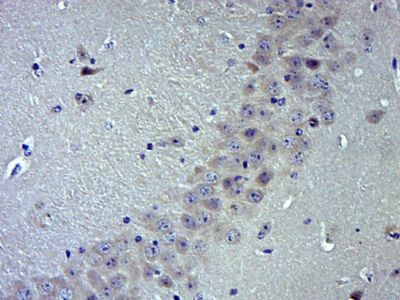The detection of noxious stimuli (chemical, mechanical, or thermal) occurs predominantly at the peripheral terminals of primary afferent neurons. This information is ultimately transmitted to the central nervous system to evoke a perception of pain which initiates appropriate protective reflexes. The receptor for capsaicin, VR1 (vanilloid receptor 1; TRPV1 is a nonselective cation channel that resembles members of the transient receptor potential (TRP) family of ion channels. The vanilloid receptor 1 protein functions both as a receptor for capsaicin and a transducter of noxious thermal stimuli. VR1 protein is localized to small-diameter sensory neurons within the dorsal root ganglia and nerve terminals in the dorsal horn.
Function:
Receptor-activated non-selective calcium permeant cation channel involved in detection of noxious chemical and thermal stimuli. Seems to mediate proton influx and may be involved in intracellular acidosis in nociceptive neurons.
Subunit:
Self-associates. Probably homotetramer. May also form a heteromeric channel with TRPV3. Interacts with calmodulin, PIRT, PRKCM and CSK. Interacts with PRKCG and NTRK1, probably by forming a trimeric complex.
Subcellular Location:
Cell junction, synapse, postsynaptic cell membrane; Multi-pass membrane protein (By similarity). Cell projection, dendritic spine membrane; Multi-pass membrane protein.
Tissue Specificity:
Widely expressed at low levels. Expression is elevated in dorsal root ganglia. In skin, expressed in cutaneous sensory nerve fibers, mast cells, epidermal keratinocytes, dermal blood vessels, the inner root sheet and the infundibulum of hair follicles, differentiated sebocytes, sweat gland ducts, and the secretory portion of eccrine sweat glands (at protein level).
Post-translational modifications:
Phosphorylation by PKA reverses capsaicin-induced dephosphorylation at multiple sites, probably including Ser-117 as a major phosphorylation site. Phoshphorylation by CAMKII seems to regulate binding to vanilloids.
Similarity:
Belongs to the transient receptor (TC 1.A.4) family. TrpV subfamily. TRPV1 sub-subfamily.
Contains 6 ANK repeats.
SWISS:
Q8NER1
Gene ID:
7442
Database links:
Entrez Gene: 7442 Human
Entrez Gene: 193034 Mouse
Entrez Gene: 83810 Rat
Omim: 602076 Human
SwissProt: Q8NER1 Human
SwissProt: Q704Y3 Mouse
SwissProt: O35433 Rat
Unigene: 579217 Human
Unigene: 655380 Human
Unigene: 447485 Mouse
Unigene: 3073 Rat
辣椒素受体(Vanilloid receptor subtype 1)是机体的一个重要的损伤性感受蛋白,参与了多种生理活动和病理过程,起到对中枢和外周水平疼痛的形成,还可以激活神经纤维末端的辣椒素受体,调节外周血管的舒缩,影响血压,对缺血心肌起到保护作用;
VR1还参与哮喘的发生,调节胃酸的分泌,促进胃肠蠕动。另外,激活辣椒素受体,还可抑制毛干的增殖,近年来发现他介导肿瘤细胞的凋亡。
| Picture |
Sample:
Spinal cord (Mouse) Lysate at 40 ug
Primary: Anti-TRPV1 (SL23926R) at 1/1000 dilution
Secondary: IRDye800CW Goat Anti-Rabbit IgG at 1/20000 dilution
Predicted band size: 92 kD
Observed band size: 92 kD
Paraformaldehyde-fixed, paraffin embedded (mouse brain); Antigen retrieval by boiling in sodium citrate buffer (pH6.0) for 15min; Block endogenous peroxidase by 3% hydrogen peroxide for 20 minutes; Blocking buffer (normal goat serum) at 37°C for 30min; Antibody incubation with (TRPV1) Polyclonal Antibody, Unconjugated (SL23926R) at 1:200 overnight at 4°C, followed by operating according to SP Kit(Rabbit) (sp-0023) instructionsand DAB staining.
Paraformaldehyde-fixed, paraffin embedded (Mouse stomach); Antigen retrieval by boiling in sodium citrate buffer (pH6.0) for 15min; Block endogenous peroxidase by 3% hydrogen peroxide for 20 minutes; Blocking buffer (normal goat serum) at 37°C for 30min; Antibody incubation with (TRPV1) Polyclonal Antibody, Unconjugated (SL23926R) at 1:400 overnight at 4°C, followed by operating according to SP Kit(Rabbit) (sp-0023) instructionsand DAB staining.
Paraformaldehyde-fixed, paraffin embedded (Mouse brain); Antigen retrieval by boiling in sodium citrate buffer (pH6.0) for 15min; Block endogenous peroxidase by 3% hydrogen peroxide for 20 minutes; Blocking buffer (normal goat serum) at 37°C for 30min; Antibody incubation with (TRPV1) Polyclonal Antibody, Unconjugated (SL23926R) at 1:400 overnight at 4°C, followed by operating according to SP Kit(Rabbit) (sp-0023) instructionsand DAB staining.
|
|
|



